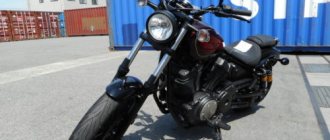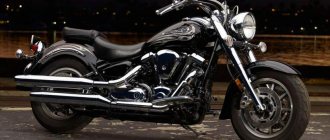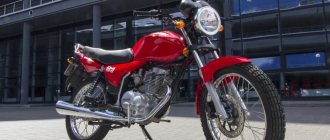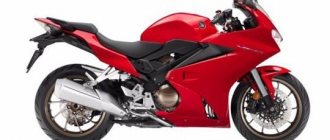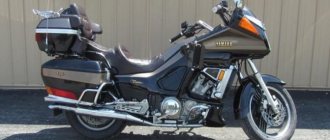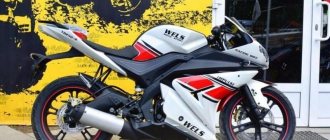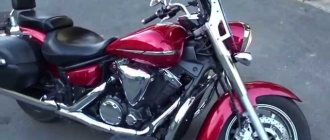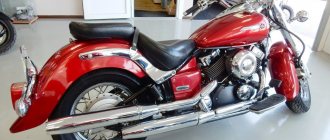Appearance
Yamaha XV 1600 Road Star looks interesting and bright. This manifests itself in different aspects. For example, the fact that it is a wide motorcycle and, at the same time, not tall. This gives it that characteristic, unique cruiser style, which is why many choose bikes of this class.
The car looks stylish thanks to the spoked wheels. Yes, cast versions are often used on this technique, but they do not have the elegance that knitting needles have. The mirrors here are elongated and teardrop-shaped. They fit in with overall design trends and the large, rounded headlight.
Comfort
The disadvantages include the lack of a backrest for the passenger. This makes the bike, with all its dimensions, not the most suitable machine for walking together, especially for long trips. Driving such a car alone is a pleasure. At least at medium speeds.
The brakes here are already disc, including at the rear. But this does not make the cruiser suitable for high-speed races on the race track. Simply because it is a cruiser, and using its engine at full power is often impractical and dangerous. This is too big, heavy and clumsy car. It is designed for smooth “gliding” along the track, but not for racing.
Dimensions and weight
The car is visually powerful and bright, primarily due to its dimensions. This equipment is larger not only than road motorcycles, but also most of its classmates. Well, there’s nothing to say about a motocross motorcycle or a sportbike.
The dimensions of the Yamaha XV 1600 Road Star are as follows:
- height – 1140 mm;
- width – 980 mm;
- length – 2500 mm;
- wheelbase – 1685 mm;
- seat height – 710 mm;
- ground clearance - 145 mm;
- curb weight – 332 kg;
- Tank capacity – 20 l.
You should not attach great importance to the volume of the tank, because the consumption here is large. Its sheer length and width make it one of the largest cruisers ever built. So, if you want to enjoy the full dynamics of this class, you should choose this or a bike of similar dimensions.
autotune
Yamaha XV 1600 Road Star , produced only for the US market for the first two years and called Wild Star , occupies an intermediate position between the Drag Star line, which includes motorcycles with engines from 400 to 1100 cc. see, and flagship models with 1.9-liter engines - Yamaha XV 1900 Stratoliner and XV 1900 Raider. This motorcycle was created primarily for the American market, and it is immediately obvious that its creators were inspired by such an iconic model as the Harley-Davidson Road King. The XV 1600 Road Star is similar to it even in appearance, but the designers went further and deprived their brainchild of balance shafts, ensuring that the motorcycle began to vibrate powerfully at idle.
By the way, the Yamaha Royal Star boasts approximately the same cubic capacity and generally similar technical characteristics, but it is distinguished by a power-hungry V-4 engine, a cardan drive and a completely different design. And the Yamaha Road Star boasts one carburetor versus two on the Drag Star series motorcycles and a belt drive to the rear wheel. Most examples have spoked wheels, but the XV 1600 Wild Star produced in 1999-2000 had cast wheels. In general, we can say that the “Star of the Road” is a typical cruiser, high-torque, heavy and quite powerful.
Yes, despite the low center of mass, its 300 kg weight is felt, especially when you have to kick it around the parking lot. There is a minimum of plastic on the motorcycle; almost all trim elements are made of thick steel coated with chrome to please Americans with their craving for vibrating and “all-iron” Harley-Davidsons. The air-cooled V-twin Yamaha Road Star 1600 produces 63 hp. and torque available from the very bottom. The engine of this cruiser is generally extremely low-speed, even by the standards of the class, and resembles a tractor. The low-end traction is impressive, but it doesn't have much high-end. However, thanks to the belt drive, all this power reaches the rear wheel with virtually no loss. The maximum speed of the Yamaha Road Star 1600 is 180 km/h, however, in this mode, fuel consumption increases catastrophically, and handling evaporates, turning a heavy cruiser, roaring with exhaust, into a cannonball moving along a straight path. But at low speeds the XV 1600 handles surprisingly nicely, much better than expected when looking at this colossus. The weight of the motorcycle ceases to be felt after reaching 15-20 km/h.
Externally, the Yamaha Road Star is a classic incarnate. Nothing extra - just old school! Huge wide seats, clearly designed for the seat of a giant, a bulging round headlight, massive fork pads, a curved steering wheel, and, of course, chrome, chrome and more chrome. Fans of classic cruisers will be thrilled to get their hands on this remarkable representative of the world of iron motorcycles. True, the standard mufflers sound mediocre - they lack rich snoring, but this can be solved with the help of tuning.
The Yamaha Road Star was produced until 2005, because it was replaced by an improved model - the XV 1700, which retained the same name - Road Star (not to be confused with the XV 1700 Warrior). The motorcycle did not gain enormous popularity, largely due to its not the lowest price, and partly due to competition with the less expensive and injector-equipped Kawasaki VN 1600, and in the eyes of Harley-Davidson fans this motorcycle is still inferior to it in terms of performance. for the simple reason that this is not a Harley. But what cannot be taken away from the XV 1600 is its thoughtful design and excellent driving characteristics.
Of course, in the city it is not so easy to move a motorcycle that weighs well over three centners and is a meter wide, but its element is not narrow streets clogged with cars, but highways. On the track, the Yamaha Road Star 1600 feels great, overtaking with ease. You can switch to fifth gear at 60-70 km/h and then drive like an automatic transmission, and the 20-liter gas tank will provide three hundred kilometers of power reserve without refueling. Yes, the XV 1600 is a classic cruiser, and fans of this class of motorcycles will undoubtedly enjoy it.
Specifications
The Yamaha XV 1600 Road Star looks interesting in the photo, but it also feels no less interesting on the road. It is enough to watch a video from a review once to be convinced of this. The car moves smoothly, but power is felt throughout its dynamics. It is felt both on a straight line and on turns.
| Motor type | V-shaped, 2 cylinders, 4 strokes |
| Power | 63.5 hp |
| Torque | 134 Nm |
| Maximum speed | 168 km/h |
| Acceleration to 100 | 5.7 s |
| Fuel consumption per hundred | 7.5 l |
| Drive unit | belt |
| Transmission | five-speed |
| Frame | tubular steel |
| Rear suspension | pendulum, monoshock absorber, stroke 110 mm |
| Front suspension | telescopic fork, travel 140 mm |
| Rear brakes | single disc, 4-piston caliper, 320 mm |
| Front brakes | two discs, 2-piston calipers, 298 mm |
The big plus of this motorcycle is that it has disc brakes not only at the front, but also at the rear. Unlike many other relatively old models, this already corresponds to today's safety standards. Thanks to the belt drive, gear shifting is almost silent.
Review of the Yamaha XV1600 motorcycle (XV1600A, Road Star, Wild Star)
The motorcycle is simply super, I am delighted with its size and speed!
Over the past 2 months I have driven about 8 thousand km. All the advantages and disadvantages were revealed during the trip to yuh. I covered 3900 km in a week. in the company of Drag Stara 1100 and Royal Stara 1300.
On the track it behaves excellently. It picks up speed quickly and confidently. Very good dynamic when overtaking, even in relation to Royal (I won’t even talk about drag) Unlike Royal, quite economical (for about 150 km 11 - 12 liters. 92 gasoline, which is 7.5 - 8 liters per hundred at cruising speed 140 km/h), unlike the Royal (13 - 14 liters per 150 km 95 gasoline). The power reserve is also quite large, considering that the tank is 22 liters.
Very good showed itself well on serpentine roads in Crimea. Confidently handles sharp turns. And, despite the air cooling, it did not warm up at all at 32 degrees on such roads with constant gear changes on ups and downs.
The belt drive is the only big plus for this transmission. Quiet running and, most importantly, no jerks at the moment of a sharp increase in speed or engine braking with gear changes. Almost no service. The belt is replaced after 70 - 80 thousand km.
I also feel quite comfortable in the city, even in big traffic jams, despite the size of the steering wheel and rear cases. Although, of course, I won’t say it, it’s much easier to move on Moscow roads during rush hour on small motorcycles.
Unfortunately, there is one drawback - almost all Roads and Wilds have 1600/1700 - when the speed increases sharply in 4th and 5th gears, the clutch begins to slip. This happens in a matter of seconds and not always, but it’s still somewhat annoying.
Doesn’t really like high revs and high speed (it starts to eat up a little oil, in 2 thousand km I ate 400 grams). Although the motorcycle itself does not provoke fast driving, you can allow yourself to reach speeds of up to 180 km/h on some sections of the route, and, having a large windshield, feel very good. comfortable. But you shouldn’t constantly move at a speed of 160 and above. I repeat - this engine does not like this. It’s better to keep this reserve of power and speed for overtaking.
I'm very. I am pleased with this motorcycle and its characteristics.
So, my motorcycle, as you may have guessed, is a Yamaha XV 1600 WildStar (European). Mot chose, somewhat by accident: he was smoking Avto.ru, looking for a relatively inexpensive multi-cubic converter to replace his dredge, and came across my handsome man. I got it in full body kit, including the batwing, panniers, Mouzon, backrest, and roll bars. The Batwing immediately went to collect dust in the garage in anticipation of a long-range drive - since most of the time I drive around the city, limiting myself to short trips out of town - it is too heavy and loud (on our pissed roads there is no need for extra load on the steering column, and the plastic rattles from the wind and vibration leads to a nervous breakdown).
Well, I'm going off topic. Most of those who wandered into this review, including, perhaps, potential owners, are interested in the “meat”, not the lyrics, so what is this motorcycle like?
Appearance.
Here, taste and color. As for me, the motorcycle is divinely beautiful: a V-shape with huge cylinders, pushers, chrome caps, a low and long “slicked-back” silhouette, spoked wheels, a belt, a one-way 2-1-2 exhaust - completely retro, in a word. Such a huge chrome-plated monster, the wheel of which you get into is like a Cadillac Eldorado.
Comfort.
The landing is classic chopper, that is, feet first, which creates certain inconveniences in the form of the inability to stand up on the footrests (well, that is, you can stand up, but frequent pull-ups on the handlebars, like on a horizontal bar, are tiring). A pilot of any height can sit behind the wheel with a straight back (if necessary, use a hexagon in his teeth and adjust the tilt of the steering wheel), which prevents his back from becoming stiff, even on long trips. The only negative for a pilot of my height (190 cm) is that when maneuvering “to the footpegs” at low speed, the handlebars rest against the legs, and you have to take your knees off, like Valentino Rossi. The saddle, or rather the SEAT, is very comfortable: soft, but in moderation, with a slight inflow that acts as a backrest. On a long drive, after 200 kilometers the rear begins to get tired; on the other hand, he stopped to refuel, kneaded his rolls and continued. The original Yamaha handles are very comfortable and “tenacious”, however, in the rain, when pawing with bare hands, you feel that there is no trace of “tenaciousness” left (motorcycle gloves will help us). The location of the buttons on the remote control is standard, as on all rice grinders. The brake and clutch levers are large and comfortable, but this is for my rather large stump; smaller drivers may experience inconvenience. The clutch is squeezed out with considerable force, so if you are not used to it, your hand will hurt, especially when driving around the city.
The suspension is moderately soft - it rides on asphalt waves like an aircraft carrier, but even when cornering at high speeds with extreme lean angles, there is no feeling of floating or breaking - wherever you steer, it goes there. The front fork is a little soft, and you can feel a dive when stopping suddenly with the front brake. Breakdowns are very rare and you can’t achieve this without effort on the part of the rider.
Safety.
Arcs are necessary. Especially for slender drivers, since keeping such a “fool” in place when exceeding a certain angle of inclination is sometimes difficult even for my very strong carcass, as they say: “God protects the best.”
I'll tell you more about the brakes next.
Reliability.
Well, it's a Yamaha, baby! The motorcycle is very reliable if you show it due respect and love, and any moron can finish off the equipment. Still, it is a low-speed (rpm limit at 4400) lower-head V-twin, after all, and therefore has a huge engine life. The first thing I want to note is that the engine is demanding on the quality of the oil; this applies both to the choice of oil and to its timely replacement. I only pour Motyul synthetics, the most viscous - because it’s an air vent, I change it after 3 - 4 thousand (maybe I’m playing it safe, but I can’t help myself). Replacement - it couldn’t be simpler - 2 drain bolts, a cartridge oil filter in the easiest access behind the wheel apron. The engine is VERY noisy - you can hear all the technological sounds, from valves to camshafts, especially when it warms up.
The motorcycle is very simple: one carb, an engine without nanotechnology - essentially nothing can break.
Ride quality.
I’ll note right away that 5 is fair by the standards of the cruiser class; don’t expect sportbike dynamics from it - that’s not what the bike is for. I often see fish on cruisers of different sizes, trying to keep up with the sport. Believe me, a Stratoliner pulled up to the cutoff, in an attempt to catch up with which CBR thread looks like that lagging behind out of breath nasorod from Jumanji - funny and pathetic.
So, you ask: “does this bike drive?” or “does the engine pull?”, what do you think? 134 Nm of torque almost from idle - of course, damn it, it pulls like a steam locomotive.
The motor is very dynamic for its class, but, which is typical, you don’t need to turn it for dynamics, 2.5 thousand is all you need. When starting from a traffic light, when you turn the throttle 1 - 1.5 mm, it accelerates faster than a scraper on a Zhiguli, and you don’t even have to switch later, you just drive in a normal cycle and may not even realize that you are participating in a race.
The engine does not like both very high speeds and very low ones. His element is from 850 to 2.5-3. To continue to twist unnecessarily is knackering. The gearbox is loud in Yamaha style - the first one turns on, so that the gazelle standing next to it shudders. Without skill, the overdrive gears also click loudly. The gears are long, up to 100 you don’t need to engage 5th at all, the main speed is 120 km/h at 2 thousand - and it’s pleasant for the ear and there is a reserve under the ass for acceleration. It is worth noting that there is no “shot” in 4th - 5th gears - the clutch begins to slip (the disc pressure spring is wasted, I will soon install a Barnett clutch with spiral springs. If you want to know the result, write in the comments - I’ll tell you how to install it). I’ll immediately dispel the rumor that after the first one you can engage 5th and drive like an automatic machine - you can’t, unless you want to throw the box, clutch, and engine in the trash in half a year. He doesn't like too low revs, as I already wrote.
Handling is excellent; for such a long wheelbase, the center of gravity is low. It lays excellently, and so does repositioning.
Brakes: 2 2-piston calipers at the front, one 4-piston at the rear. On the zero Midnight 1900 there is a 2-piston rear! For its weight, the motorcycle has very high braking dynamics. The brakes are not very informative (the pedal and lever have long travel), but they are difficult to press.
That's all for now, if I remember anything else, I'll write.
After riding the motorcycle I chose after much torment for three years, I got around to writing a detailed review. Almost forty thousand kilometers have been traveled along the roads of Russia and abroad, so there is something to talk about. And I can say that the Yamaha XV 1600 Road Star is a more than worthy motorcycle. Designed for the American market, it actually copies the style and charisma of Harley-Davidson, but somehow it cannot be blamed for it.
Yes, as for his appearance, we see a classic incarnate. Nothing superfluous, no innovations, no flirting with style like the Stratoliner - only old school, only hardcore. It depends on everyone, but I personally really like this style, which is why I fell in love with Road Star at one time. True, I wanted the injection XV 1700, but as a result the budget was only enough for the carburetor 65-horsepower XV 1600. However, when I had a chance to drive the injection, more recent version, I did not feel a difference in dynamics up to about 120 mph, despite the differences in the passport one and a half dozen horsepower.
I got the motorcycle in the solo version, without a back seat and any body kit. So I drove for a couple of years until, due to circumstances, I had to install standard seats and panniers. My Road Star traveled mainly around Russia, and I don’t need a lot of luggage, so I managed just like that. By the way, the bike is very suitable for long-distance riders, if, of course, you are also a fan of classic choppers. There is no need to be afraid of vibrations caused by design features - they are noticeable only at idle, but once you get going, they disappear, gradually starting to return from about 130 mph in fifth gear.
It is worth noting that the Yamaha Road Star is a heavy motorcycle. However, I, a person of the most average build, coped with it easily, but here, perhaps, it’s more a matter of experience. The low-speed engine of the XV 1600, spinning only up to 4 thousand revolutions, like on some Volga, does not have high power - it is comparable to the power of a liter Dragstar, but the heavy torque makes the heavy cruiser very dynamic. At least up to 100-120 mph, after which the acceleration becomes more sluggish. But it was always enough for me, especially since I usually never drove faster than 130-140 km/h.
Since the Road Star 1600 is a large motorcycle, it is really comfortable to sit on it, and there is no desire to make leg extensions or, for example, move the handlebars back. As operation has shown, if there is a passenger backrest, it is also a sin for the passenger sitting behind to complain about comfort. So everything is on point here, the only pity is that there is no tachometer and a full-fledged fuel level sensor. Although the tank is enough for about 250-260 kilometers on the highway and about 200 km in urban conditions. I always filled with 92 gasoline.
The pendants are so-so, to be honest, but it depends on what you compare with. They are “so-so” if you compare them with some tourist, but compared to their classmates they are no worse and no better. But the brakes are excellent - after the Suzuki Intruder VL1500, they turned out to be simply awesome. Although I did install reinforced hoses with fittings in the end, that's another story. It handles well too, at least better than you'd expect from a bike as big and heavy as the Road Star.
As for reliability, there were no problems, at least serious ones. During operation, the fork seals and boots, the carburetor air pipe and the Hall sensor, which died for an unknown reason, were changed. The main drive belt was also changed, and it cost a lot, but it is a consumable, not a spare part, but all the breakdowns were fixed on a budget. Maintenance is also not laborious - you can do everything yourself in the garage.
Smooth roads everyone!
Pros - confidently holds the road; Beautiful; abundance of metal parts; a lot of original and high-quality Yamaha tuning and non-original tuning; In America there are examples with a mileage of up to 200 or more thousand miles, without capital.
Cons - the maximum speed of the first models is only 160 km/h (but that’s enough for me); Quite average traction compared to some VTX 1800 or m109 (but it’s enough for me); in traffic jams, well, you can imagine it’s heavy and hot, the engine soars, but does not overheat; The first models had two two-piston brackets at the front; after restyling, I think in 2001, they began installing two 4-piston ones; Requires periodic belt tightening.
A very beautiful, large and heavy motorcycle with a big twin, combined with HD and designed for the target consumer.
I consider this motorcycle to be almost perfect.
What do the owners say?
According to the reviews of those who managed to buy a new bike, this is a great machine. However, the bike is also praised by those who purchased a used copy. By the way, even a used car will cost no less than 300 thousand Russian rubles. Maintenance is also not cheap, considering how much it costs to purchase certain parts.
However, servicing this equipment is unlikely to be difficult. If the bike is initially in good condition and is used carefully, then the likelihood of breakdown is low. However, owners are advised to always remember that this machine is not intended for rough terrain. Bad roads will also not be good for technology.
According to the description of residents of provincial cities, this car is inconvenient in the yard. And in the city, riding such a huge bike is not particularly comfortable. Yes, such equipment, in principle, is not intended for city streets. A spacious country road is her element. If you need a bike for the city, you won't find anything better than a road bike.
Those who drove this cruiser on a track suitable for this “liner” were delighted. Smooth and powerful ride, leisurely but confident turning, unshakable stability and comfortable tactile sensations. Here are the first impressions this model leaves from Yamaha.
In conclusion, it is worth noting that the Yamaha XV 1600 Road Star is one of the best cruisers not only of its era, but also in principle. Large and bright, it perfectly conveys the unique smooth and powerful dynamics characteristic of cruisers. That's why the model is still so popular among bikers. And we’re not just talking about connoisseurs of old cruisers.
Review of the Yamaha XV1600 (XV1600A, Road Star, Wild Star) motorcycle
The motorcycle is simply super, I am delighted with its size and speed!
Over the past 2 months I have driven about 8 thousand km. All the advantages and disadvantages were revealed during the trip to yuh. I covered 3900 km in a week. in the company of Drag Stara 1100 and Royal Stara 1300.
On the track it behaves excellently. It picks up speed quickly and confidently. Very good dynamic when overtaking, even in relation to Royal (I won’t even talk about drag) Unlike Royal, quite economical (for about 150 km 11 - 12 liters. 92 gasoline, which is 7.5 - 8 liters per hundred at cruising speed 140 km/h), unlike the Royal (13 - 14 liters per 150 km 95 gasoline). The power reserve is also quite large, considering that the tank is 22 liters.
Very good showed itself well on serpentine roads in Crimea. Confidently handles sharp turns. And, despite the air cooling, it did not warm up at all at 32 degrees on such roads with constant gear changes on ups and downs.
The belt drive is the only big plus for this transmission. Quiet running and, most importantly, no jerks at the moment of a sharp increase in speed or engine braking with gear changes. Almost no service. The belt is replaced after 70 - 80 thousand km.
I also feel quite comfortable in the city, even in big traffic jams, despite the size of the steering wheel and rear cases. Although, of course, I won’t say it, it’s much easier to move on Moscow roads during rush hour on small motorcycles.
Unfortunately, there is one drawback - almost all Roads and Wilds have 1600/1700 - when the speed increases sharply in 4th and 5th gears, the clutch begins to slip. This happens in a matter of seconds and not always, but it’s still somewhat annoying.
Doesn’t really like high revs and high speed (it starts to eat up a little oil, in 2 thousand km I ate 400 grams). Although the motorcycle itself does not provoke fast driving, you can allow yourself to reach speeds of up to 180 km/h on some sections of the route, and, having a large windshield, feel very good. comfortable. But you shouldn’t constantly move at a speed of 160 and above. I repeat - this engine does not like this. It’s better to keep this reserve of power and speed for overtaking.
I'm very. I am pleased with this motorcycle and its characteristics.
So, my motorcycle, as you may have guessed, is a Yamaha XV 1600 WildStar (European). Mot chose, somewhat by accident: he was smoking Avto.ru, looking for a relatively inexpensive multi-cubic converter to replace his dredge, and came across my handsome man. I got it in full body kit, including the batwing, panniers, Mouzon, backrest, and roll bars. The Batwing immediately went to collect dust in the garage in anticipation of a long-range drive - since most of the time I drive around the city, limiting myself to short trips out of town - it is too heavy and loud (on our pissed roads there is no need for extra load on the steering column, and the plastic rattles from the wind and vibration leads to a nervous breakdown).
Well, I'm going off topic. Most of those who wandered into this review, including, perhaps, potential owners, are interested in the “meat”, not the lyrics, so what is this motorcycle like?
Appearance.
Here, taste and color. As for me, the motorcycle is divinely beautiful: a V-shape with huge cylinders, pushers, chrome caps, a low and long “slicked-back” silhouette, spoked wheels, a belt, a one-way 2-1-2 exhaust - completely retro, in a word. Such a huge chrome-plated monster, the wheel of which you get into is like a Cadillac Eldorado.
Comfort.
The landing is classic chopper, that is, feet first, which creates certain inconveniences in the form of the inability to stand up on the footrests (well, that is, you can stand up, but frequent pull-ups on the handlebars, like on a horizontal bar, are tiring). A pilot of any height can sit behind the wheel with a straight back (if necessary, use a hexagon in his teeth and adjust the tilt of the steering wheel), which prevents his back from becoming stiff, even on long trips. The only negative for a pilot of my height (190 cm) is that when maneuvering “to the footpegs” at low speed, the handlebars rest against the legs, and you have to take your knees off, like Valentino Rossi. The saddle, or rather the SEAT, is very comfortable: soft, but in moderation, with a slight inflow that acts as a backrest. On a long drive, after 200 kilometers the rear begins to get tired; on the other hand, he stopped to refuel, kneaded his rolls and continued. The original Yamaha handles are very comfortable and “tenacious”, however, in the rain, when pawing with bare hands, you feel that there is no trace of “tenaciousness” left (motorcycle gloves will help us). The location of the buttons on the remote control is standard, as on all rice grinders. The brake and clutch levers are large and comfortable, but this is for my rather large stump; smaller drivers may experience inconvenience. The clutch is squeezed out with considerable force, so if you are not used to it, your hand will hurt, especially when driving around the city.
The suspension is moderately soft - it rides on asphalt waves like an aircraft carrier, but even when cornering at high speeds with extreme lean angles, there is no feeling of floating or breaking - wherever you steer, it goes there. The front fork is a little soft, and you can feel a dive when stopping suddenly with the front brake. Breakdowns are very rare and you can’t achieve this without effort on the part of the rider.
Safety.
Arcs are necessary. Especially for slender drivers, since keeping such a “fool” in place when exceeding a certain angle of inclination is sometimes difficult even for my very strong carcass, as they say: “God protects the best.”
I'll tell you more about the brakes next.
Reliability.
Well, it's a Yamaha, baby! The motorcycle is very reliable if you show it due respect and love, and any moron can finish off the equipment. Still, it is a low-speed (rpm limit at 4400) lower-head V-twin, after all, and therefore has a huge engine life. The first thing I want to note is that the engine is demanding on the quality of the oil; this applies both to the choice of oil and to its timely replacement. I only pour Motyul synthetics, the most viscous - because it’s an air vent, I change it after 3 - 4 thousand (maybe I’m playing it safe, but I can’t help myself). Replacement - it couldn’t be simpler - 2 drain bolts, a cartridge oil filter in the easiest access behind the wheel apron. The engine is VERY noisy - you can hear all the technological sounds, from valves to camshafts, especially when it warms up.
The motorcycle is very simple: one carb, an engine without nanotechnology - essentially nothing can break.
Ride quality.
I’ll note right away that 5 is fair by the standards of the cruiser class; don’t expect sportbike dynamics from it - that’s not what the bike is for. I often see fish on cruisers of different sizes, trying to keep up with the sport. Believe me, a Stratoliner pulled up to the cutoff, in an attempt to catch up with which CBR thread looks like that lagging behind out of breath nasorod from Jumanji - funny and pathetic.
So, you ask: “does this bike drive?” or “does the engine pull?”, what do you think? 134 Nm of torque almost from idle - of course, damn it, it pulls like a steam locomotive.
The motor is very dynamic for its class, but, which is typical, you don’t need to turn it for dynamics, 2.5 thousand is all you need. When starting from a traffic light, when you turn the throttle 1 - 1.5 mm, it accelerates faster than a scraper on a Zhiguli, and you don’t even have to switch later, you just drive in a normal cycle and may not even realize that you are participating in a race.
The engine does not like both very high speeds and very low ones. His element is from 850 to 2.5-3. To continue to twist unnecessarily is knackering. The gearbox is loud in Yamaha style - the first one turns on, so that the gazelle standing next to it shudders. Without skill, the overdrive gears also click loudly. The gears are long, up to 100 you don’t need to engage 5th at all, the main speed is 120 km/h at 2 thousand - and it’s pleasant for the ear and there is a reserve under the ass for acceleration. It is worth noting that there is no “shot” in 4th - 5th gears - the clutch begins to slip (the disc pressure spring is wasted, I will soon install a Barnett clutch with spiral springs. If you want to know the result, write in the comments - I’ll tell you how to install it). I’ll immediately dispel the rumor that after the first one you can engage 5th and drive like an automatic machine - you can’t, unless you want to throw the box, clutch, and engine in the trash in half a year. He doesn't like too low revs, as I already wrote.
Handling is excellent; for such a long wheelbase, the center of gravity is low. It lays excellently, and so does repositioning.
Brakes: 2 2-piston calipers at the front, one 4-piston at the rear. On the zero Midnight 1900 there is a 2-piston rear! For its weight, the motorcycle has very high braking dynamics. The brakes are not very informative (the pedal and lever have long travel), but they are difficult to press.
That's all for now, if I remember anything else, I'll write.
After riding the motorcycle I chose after much torment for three years, I got around to writing a detailed review. Almost forty thousand kilometers have been traveled along the roads of Russia and abroad, so there is something to talk about. And I can say that the Yamaha XV 1600 Road Star is a more than worthy motorcycle. Designed for the American market, it actually copies the style and charisma of Harley-Davidson, but somehow it cannot be blamed for it.
Yes, as for his appearance, we see a classic incarnate. Nothing superfluous, no innovations, no flirting with style like the Stratoliner - only old school, only hardcore. It depends on everyone, but I personally really like this style, which is why I fell in love with Road Star at one time. True, I wanted the injection XV 1700, but as a result the budget was only enough for the carburetor 65-horsepower XV 1600. However, when I had a chance to drive the injection, more recent version, I did not feel a difference in dynamics up to about 120 mph, despite the differences in the passport one and a half dozen horsepower.
I got the motorcycle in the solo version, without a back seat and any body kit. So I drove for a couple of years until, due to circumstances, I had to install standard seats and panniers. My Road Star traveled mainly around Russia, and I don’t need a lot of luggage, so I managed just like that. By the way, the bike is very suitable for long-distance riders, if, of course, you are also a fan of classic choppers. There is no need to be afraid of vibrations caused by design features - they are noticeable only at idle, but once you get going, they disappear, gradually starting to return from about 130 mph in fifth gear.
It is worth noting that the Yamaha Road Star is a heavy motorcycle. However, I, a person of the most average build, coped with it easily, but here, perhaps, it’s more a matter of experience. The low-speed engine of the XV 1600, spinning only up to 4 thousand revolutions, like on some Volga, does not have high power - it is comparable to the power of a liter Dragstar, but the heavy torque makes the heavy cruiser very dynamic. At least up to 100-120 mph, after which the acceleration becomes more sluggish. But it was always enough for me, especially since I usually never drove faster than 130-140 km/h.
Since the Road Star 1600 is a large motorcycle, it is really comfortable to sit on it, and there is no desire to make leg extensions or, for example, move the handlebars back. As operation has shown, if there is a passenger backrest, it is also a sin for the passenger sitting behind to complain about comfort. So everything is on point here, the only pity is that there is no tachometer and a full-fledged fuel level sensor. Although the tank is enough for about 250-260 kilometers on the highway and about 200 km in urban conditions. I always filled with 92 gasoline.
The pendants are so-so, to be honest, but it depends on what you compare with. They are “so-so” if you compare them with some tourist, but compared to their classmates they are no worse and no better. But the brakes are excellent - after the Suzuki Intruder VL1500, they turned out to be simply awesome. Although I did install reinforced hoses with fittings in the end, that's another story. It handles well too, at least better than you'd expect from a bike as big and heavy as the Road Star.
As for reliability, there were no problems, at least serious ones. During operation, the fork seals and boots, the carburetor air pipe and the Hall sensor, which died for an unknown reason, were changed. The main drive belt was also changed, and it cost a lot, but it is a consumable, not a spare part, but all the breakdowns were fixed on a budget. Maintenance is also not laborious - you can do everything yourself in the garage.
Smooth roads everyone!
Pros - confidently holds the road; Beautiful; abundance of metal parts; a lot of original and high-quality Yamaha tuning and non-original tuning; In America there are examples with a mileage of up to 200 or more thousand miles, without capital.
Cons - the maximum speed of the first models is only 160 km/h (but that’s enough for me); Quite average traction compared to some VTX 1800 or m109 (but it’s enough for me); in traffic jams, well, you can imagine it’s heavy and hot, the engine soars, but does not overheat; The first models had two two-piston brackets at the front; after restyling, I think in 2001, they began installing two 4-piston ones; Requires periodic belt tightening.
A very beautiful, large and heavy motorcycle with a big twin, combined with HD and designed for the target consumer.
I consider this motorcycle to be almost perfect.
Go to motorcycle Yamaha XV1600 (XV1600A, Road Star, Wild Star)
Check out the test drives:
- Yamaha XV1600A: Test drive
- Yamaha XV1600A: Comparative test drive with Kawasaki VN1500 Vulcan Drifter
